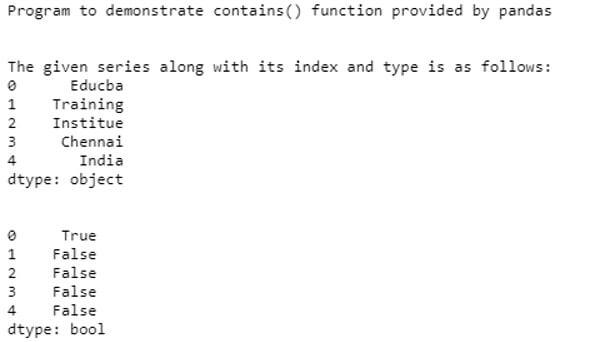Updated April 11, 2023

Introduction to Python String Contains
In this article, we will see the string method for checking if the given substring is present in the given string and return true if it is present else it returns false such string method is known as _contains_() method of String class in Python. In Python, pandas also provide series.str.contains the () function to check if the pattern given is contained in the given string of series and this function also returns a Boolean value such as true if the pattern is present in the string of series and false if not present. There are other different ways also for checking if the string is present or not in the given another string in Python such as using a regular expression, “in” operator, find(), etc.
Working of string _contains_() Function in Python
In this article, we will see the string class provides _contains_() method for testing if there is a presence of a given substring in the string. In Python, there is another module named “operator” which also provides contains() function and this function also works similarly to the _contains_() function of string class. There is also another option to find the string of series using pandas which will also provide function series.str.contains() to check for the presence of a given pattern in the string of series.
Now let us demonstrate the above functions with examples:
Python has built-in string function for finding substring in the given string using String._contains_() function.
Syntax:
str._contains_(substring)So this function _contains_() takes two strings. In the above syntax, we can see “str” is a string object which has one string and “substring” has another string. So, in general, the working of this function is it will check if the string object “str” in the syntax contains a string (substring) specified or passed as an argument to the _contains_() function. We should note that this function is case-sensitive.
Example of Python String Contains
Below are the different examples of Python String Contains:
Example #1
Code:
print("Python program to demonstrate _contains_() function")
print("\n")
str1 = "Educba Training"
sub_str = "Educba"
if (str1.__contains__(sub_str)):
print("The given String contains the given substring")
print(sub_str)
print("\n")
else:
print("The given String does not contain substring")Output:
In the above program, we can see that we have declared a string “str1” as “Educba Training” and “sub_str” as “Educba”. Then using the “if” statement we will check for the presence of a substring in the given string using _contains_() function which results in true value and therefore it prints the substring and if it is not present then it will return false.
The above string function _contains_() can be made as a class method also and this can be done by using two parameters to the method of the String class str.
Syntax:
o = str_cl._contains_(s1, s2)So this function is invoked as a class method on string class and this function will return true if s1 string contains s2 string else it returns false.
Code:
print(str.__contains__("Educba Training Institute", "Institute"))Output:
Now we will see how “operator” module of Python provides contains() function which also works similarly to the string function _contains_() and let us demonstrate it in the below example.
Example #2
Code:
import operator
print("Python program to demonstrate contains() function of operator module ")
print("\n")
str1 = "Educba is best in programming courses."
if operator.contains(str1, "best"):
print ("The given substring is present in the string.")
else :
print ("The given substring is not present in the string.")Output:
In the above program, we can see we have declared one string “str1” and a substring is specified inside the function argument. To run this program we must first need to import the “operator” module and then we can use the operator.contains() function which will search for substring mentioned as the second argument in the given string mentioned as first argument str1 of the function if this function returns true then it will print the substring is present else if it returns false then it will print substring not present. The output can be seen in the above screenshot.
Now let us see another contains() function used in pandas to find the pattern in the string of series using series.str.contains().
Let us demonstrate this function in the below program with syntax.
Syntax:
Series.str.contains(pat, case=True, flags=0, na=nan, regex=True)- pat: Parameter to specify the characters or substring or regular expression.
- case: True, this parameter is set to true as to say this function is case sensitive.
- flag: It is used for going through the re module.
- na: Which is always none, to fill values for missing values.
- regex: This parameter is set to true if the pat parameter is regular expression else it is set to false as pat is a literal string.
Example #3
Code:
import pandas as pd
print("Program to demonstrate contains() function provided by pandas")
print("\n")
sr = pd.Series(['Educba', 'Training', 'Institue', 'Chennai', 'India'])
print("The given series along with its index and type is as follows:")
print(sr)
print("\n")
r = sr.str.contains('Edu')
print(r)Output:
In the above program, we first need to import pandas to use pandas function series.str.contains(). In the above program, we have created a series using pandas object pd, and each one is given index in the series and we can see it in the output. Then we are using series.str.contains() and we are passing a substring “Edu” which will search in the string of series that was created and declared as “sr” in the above program. Therefore, when we print the result of the function then it will print the Boolean values of each string in the series along with index number as to in which string the given substring is present it will result in true else it will return false.
Conclusion
In this article, we conclude that the contains() function of string in Python is used in many different ways and is provided in different modules also and this function working is the same such as to find the substring or string in another string. In this article, we saw how the string _contains_() function is used and how it can be used as a class method of string class. In this article, we also saw modules like operator and pandas also provide contains() function. We saw in pandas it is used to find the pattern or substring in the string of series created using pandas object and respective examples are given for demonstration.
Recommended Articles
We hope that this EDUCBA information on “Python String Contains” was beneficial to you. You can view EDUCBA’s recommended articles for more information.



